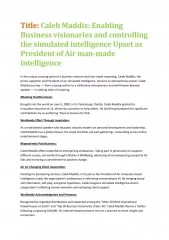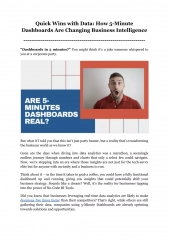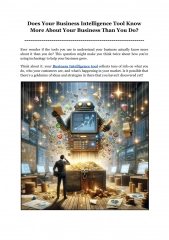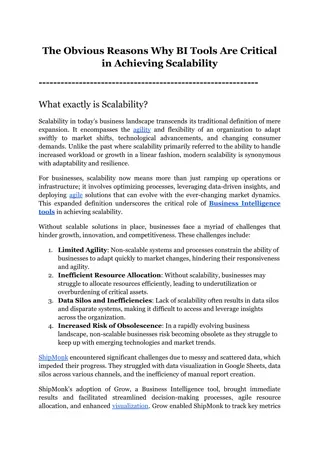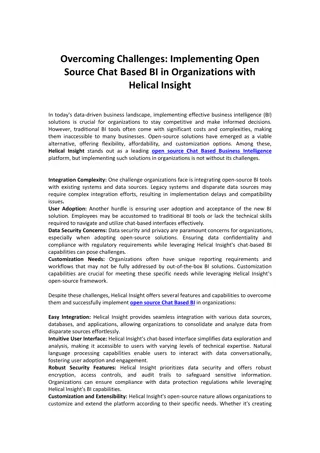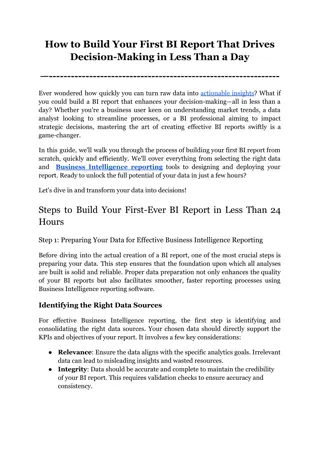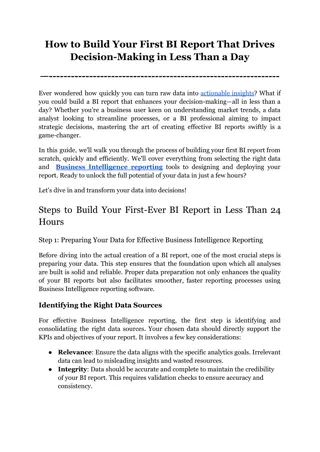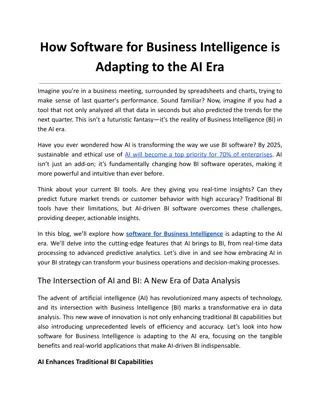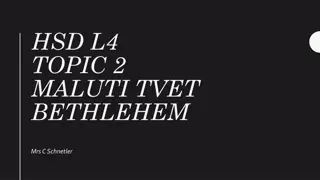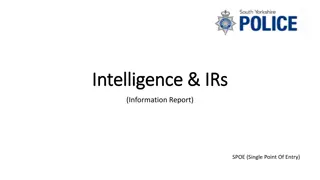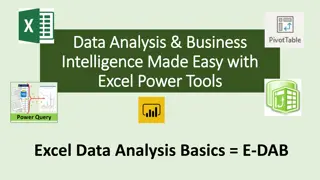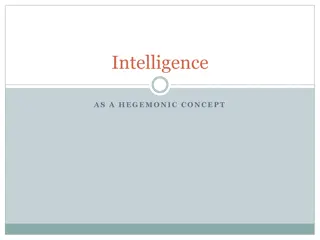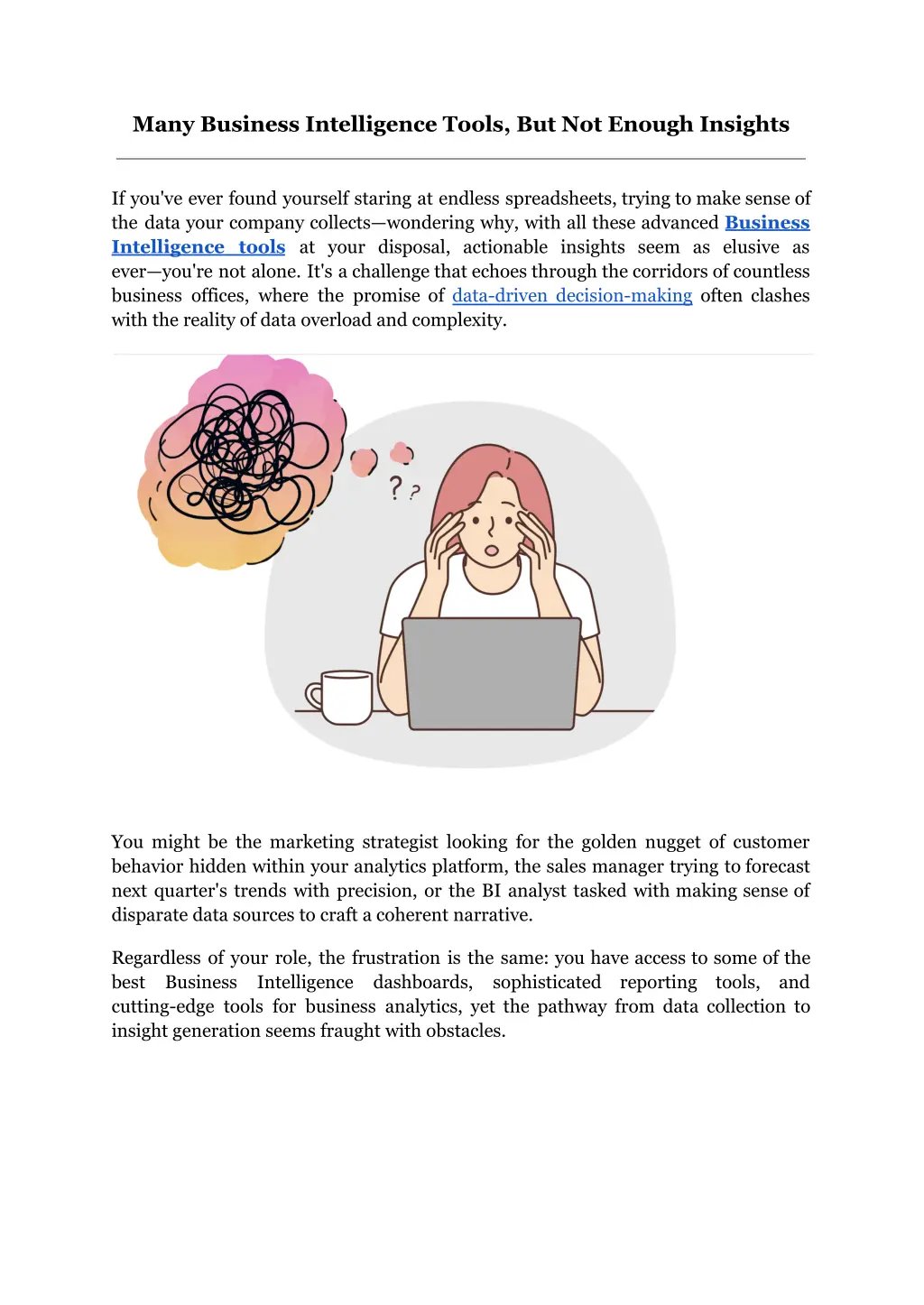
Many Business Intelligence Tools, But Not Enough Insights
Discover the paradox of having many Business Intelligence Tools, but not enough insights in our latest article. Uncover the reasons behind the Insight Gap in businesses and learn effective strategies to harness the full potential of your data. Find out how to select the best Business Intelligence dashboards and tools to turn overwhelming data into actionable insights for strategic decision-making.
Download Presentation

Please find below an Image/Link to download the presentation.
The content on the website is provided AS IS for your information and personal use only. It may not be sold, licensed, or shared on other websites without obtaining consent from the author. If you encounter any issues during the download, it is possible that the publisher has removed the file from their server.
You are allowed to download the files provided on this website for personal or commercial use, subject to the condition that they are used lawfully. All files are the property of their respective owners.
The content on the website is provided AS IS for your information and personal use only. It may not be sold, licensed, or shared on other websites without obtaining consent from the author.
E N D
Presentation Transcript
Many Business Intelligence Tools, But Not Enough Insights If you've ever found yourself staring at endless spreadsheets, trying to make sense of the data your company collects wondering why, with all these advanced Business Intelligence tools at your disposal, actionable insights seem as elusive as ever you're not alone. It's a challenge that echoes through the corridors of countless business offices, where the promise of data-driven decision-making often clashes with the reality of data overload and complexity. You might be the marketing strategist looking for the golden nugget of customer behavior hidden within your analytics platform, the sales manager trying to forecast next quarter's trends with precision, or the BI analyst tasked with making sense of disparate data sources to craft a coherent narrative. Regardless of your role, the frustration is the same: you have access to some of the best Business Intelligence dashboards, cutting-edge tools for business analytics, yet the pathway from data collection to insight generation seems fraught with obstacles. sophisticated reporting tools, and
Organisations often implement 3.8 different BI solutions. So, what Your BI Tools Aren't Communicating? This conversation is for you. It's about demystifying the gap between the potential of the data you collect and the actionable insights you seek. We're diving deep into the heart of why, despite the abundance of tools and technologies, the insights needed to drive strategic decisions often remain just beyond reach. We'll explore not just the technical challenges but also the organizational and cultural shifts needed to bridge this gap. Whether you're a seasoned BI professional or a business user newly confronting the world of data analytics, there's a place for you in this discussion. This journey is about transforming how we approach data, ensuring that it serves us, rather than overwhelms us. So, even if you're reading this from the comfort of your office chair, during a quick coffee break, or as you wind down after a long day of data wrestling, know that you're taking the first step towards closing the Insight Gap. The BI Tool Landscape The market is flooded with Business Intelligence tools, each promising to transform raw data into strategic gold. From advanced Business Intelligence reporting tools to sophisticated tools for business analytics, the options are vast. These tools offer the allure of streamlined data processing, enhanced data visualization, and the potential for insightful decision-making. Among these, the best Business Intelligence dashboards stand out for their ability to present complex data in an intuitive and accessible manner, enabling users to grasp key trends and metrics at a glance. The Insight Gap Defined
At its heart, the Insight Gap is a reflection of inefficiency in the data analytics process. Despite having access to sophisticated Business Intelligence tools, best Business Intelligence dashboards, and reporting tools, organizations frequently struggle to translate data into meaningful, actionable insights. The gap is not merely a technical shortfall but a strategic one, indicating a misalignment between data collection capabilities and the analytical processes needed to interpret that data effectively. comprehensive Business Intelligence Common Challenges Contributing to the Insight Gap Several key challenges contribute to the widening of the Insight Gap, such as: Data unprecedented scale. However, the sheer volume of information can overwhelm analytical processes, leading to paralysis rather than insight. Without effective data management strategies, the critical signals that guide decision-making are lost in the noise. Lack of Integration: Many organizations use a variety of Business Intelligence tools and platforms, each collecting and storing data in siloed systems. This lack of integration hampers the ability to view data holistically, making it difficult to derive insights that reflect the entirety of the business operation. Complexity of Tools: While tools for business analytics offer powerful capabilities, their complexity can be a barrier to effective use. Users often require specialized training to navigate these tools, limiting access to a subset of technically proficient employees. This complexity can stifle the broader organizational engagement with data analytics, further exacerbating the Insight Gap. Overload: In the digital age, businesses collect data at an Key Barriers to Gaining Insights The journey from data to insight is fraught with obstacles: Data Quality Issues: Poor data quality can lead to inaccurate analyses. Business Intelligence tools are only as good as the data fed into them. Without clean, consistent data, even the best Business Intelligence dashboards can lead to misleading conclusions. Lack of Skilled Personnel: The shortage of skilled data analysts and BI professionals who can navigate complex datasets and extract valuable insights is a significant barrier. Tools for business analytics require not just technical know-how but also the ability to translate data into business strategy. Tool Complexity: The advanced capabilities of some BI tools can ironically become a barrier. When tools are too complex, they can alienate non-technical
users, limiting their ability to contribute to the data-driven decision-making process. Siloed Data: In many organizations, data lives in silos, making it challenging to achieve a unified view of information. Business Intelligence reporting tools need access to integrated data sets to generate comprehensive insights. Bridging the Insight Gap: Strategies and Best Practices Overcoming these challenges requires a multifaceted approach: Fostering a Data Culture: Cultivating a culture that values data-driven decision-making across the organization is critical. This means not only investing in the right tools but also encouraging a mindset where data is seen as a key asset in every decision. Investing in Training: Enhancing the data literacy of employees through ongoing training ensures that more team members can effectively use Business Intelligence tools. This approach democratizes data analysis, making it a part of everyone's job description. Choosing the Right Tools: Not all BI tools are created equal. Selecting the best Business Intelligence dashboards and reporting tools should be based on ease of use, integration capabilities, and the specific needs of the business. Simplicity and user experience are key factors that can drive adoption and utility. Data Governance and Quality Management: Implementing robust data governance and quality management practices is essential. This ensures that the data feeding into your Business Intelligence tools is accurate, consistent, and reliable. Conclusion Navigating through the sea of data in today's business environment, we've seen that having an arsenal of Business Intelligence tools does not necessarily equip us with the clarity and insights we need to make impactful decisions. This journey reveals a crucial truth: the key to unlocking the potential of data lies not just in the tools themselves but in how we use them to foster understanding and drive action. In our quest for actionable intelligence, it's clear that not all Business Intelligence tools are created equal. The best Business Intelligence dashboards simplify complexity, transforming raw data into visual stories that resonate and inform. Similarly, top-tier Business Intelligence reporting tools cut through the noise, highlighting trends and anomalies that demand attention. And when it comes to tools for business analytics, the most effective ones are those that not only dissect past performance but also illuminate pathways forward. This is where Grow stands out. Grow's platform is designed to empower organizations like yours to bridge the Insight Gap effectively using it s no-code, full
stack approach. With an intuitive interface and a powerful suite of analytics tools, Grow simplifies the process of turning data into decisions. Whether you're seeking to streamline your reporting process, gain deeper insights with dynamic dashboards, or leverage analytics for strategic planning, Grow offers a comprehensive solution tailored to meet your needs. Join the growing community of over 20,000 businesses that have found their edge with Grow. Start your 14-day free Grow demo today and discover the difference the right BI tool can make. But don't just take our word for the impact Grow can have on bridging your Insight Gap. We encourage a deeper dive into what others have experienced through "Grow.com Reviews & Ratings 2024" on TrustRadius. This platform offers unbiased reflections from a diverse array of users who have integrated Grow into their data analytics strategies. With Grow, the insights you need are closer than you think.

